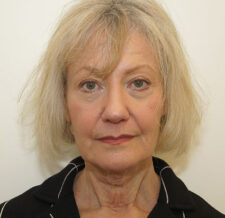A facelift, medically referred to as rhytidectomy, is a cosmetic procedure designed to reduce signs of aging in the face and achieve a more rejuvenated and rested appearance. Using a variety of leading techniques, including the deep plane approach, Dr. Neal Goldberg can lift sagging facial tissues and position them to a higher, more youthful location. Excess skin is often removed as well, and natural-looking results are emphasized.
What Is A Facelift?
The facelift procedure is one of the most popular cosmetic procedures performed in the U.S. On average, patients can look over 11 years younger and may experience improved self-confidence. In this procedure, advanced techniques are used to remove excess fat, tighten underlying tissues in the face, and redrape the skin of the face and neck.
Facelifts can correct many issues, including sagging jowls, deep nasolabial folds, excess skin, folds or fat deposits around the neck, and a sagging face or neck. Most patients who undergo the procedure are between 40 and 60 years old. Ideal patients are healthy non-smokers. You should notify our board-certified plastic surgeon if you suffer from high blood pressure, problems with blood clotting, or you have a tendency to form excessive scars.
What Can A Facelift Accomplish?
Years of aging can cause our faces to sag, making us look older. If you suffer from excess sagging skin in their lower face, Dr. Neal Goldberg is proud to offer facelift procedures to correct these signs of aging. These facial plastic surgery procedures can help:
- Reverse signs of aging in the lower face/neck
- Remove excess fat/skin
- Fix sagging jowls
- Correct deep nasolabial folds
A consultation with our board-certified plastic surgeon can give you insight into whether a facelift would address your concerns and help you achieve the look you desire. Facelift surgery is personalized to your unique needs and can restore a more youthful version of yourself while preserving the natural character of your face.
Is A Facelift Right For Me?
Factors that should be considered when determining whether a facelift would benefit you are similar to the requirements for any cosmetic procedure: you should have realistic expectations for the outcome, be relatively healthy enough to undergo the recovery process, and be willing to quit smoking for several weeks before and after surgery.
Candidacy for a facelift in particular also depends on whether the signs of age you wish to improve are concentrated in the lower face. Facelift surgery can rejuvenate the jowls and neck, but the procedure is not designed to correct a sagging brow, tired eyes, or other concerns in the upper third of the face. Dr. Goldberg can perform other facial plastic surgery procedures, such as a brow lift or eyelid surgery, at the same time as your facelift if you would like a more comprehensive result.

What Can I Expect From The Facelift Procedure?
A facelift procedure is highly individualized and may be performed on either an inpatient or outpatient basis. The surgery can take 2-3 hours to complete and is often done utilizing general anesthesia.
During the procedure, Dr. Goldberg makes incisions above the hairline at the temples, where they will be well-concealed and follow the natural contour in front of the ear, continuing behind the earlobe to the lower scalp. The doctor separates the skin from the underlying fat and tissue. Excess fat is then trimmed or extracted using liposuction to improve the contour of the neck or chin. Dr. Goldberg then tightens the underlying tissues and lifts and removes excess skin. If the neck is being improved, a small incision is also made under the chin. Finally, stitches will be used to fixate the tissue layers and close the incisions.
In some cases, Dr. Goldberg may choose to perform an SMAS facelift. If you undergo this procedure, the tissue underneath the skin will be lifted to decrease the sagginess of the jowls and lower face. The SMAS facelift technique is similar to the popular “Lifestyle Lift” and “Freedom Lift” in that all three techniques deal with tightening the tissues beneath your skin.
Mini Facelift
If Dr. Goldberg decides you are a good candidate for a mini facelift, which is also referred to as a “mid-facelift” or the “short scar” facelift technique, you can expect minimal to no scarring behind the ear and within the hairline. A mini facelift is performed very similarly to a full facelift, but uses a less invasive approach to tighten the deeper facial tissues. The cheeks are still lifted and tightened to minimize jowling, but aging in the neck is not usually addressed. Patients may benefit from this less extensive version of a facelift if they exhibit mild jowling and want to improve subtle signs of aging before they become too pronounced. Dr. Goldberg may perform a facelift under local anesthesia combined with sedation, or under general anesthesia. He will discuss your goals with you during your consultation and decide the best technique for your needs.
What Is Recovery Like Following A Facelift?
How Long Will Facelift Results Last?
While no one can say for sure how long the effects will last, some patients have been known to enjoy the results for 10-15 years or more if they maintain excellent skin care, avoid smoking and sun damage, and engage in other beneficial habits. Dr. Goldberg uses some of the most advanced facelift techniques available, which are designed to provide longer-lasting results than many traditional methods. Additionally, occasional non-surgical cosmetic treatments, such as dermal fillers, can extend the outcome even longer for some people. You are welcome to ask Dr. Goldberg what you can do to get the most out of your procedure during your initial consultation, or at any time you’re meeting with him.
Key Treatments to Preserve Facelift Results
While the outcome of a facelift generally offers the greatest longevity when compared to other facial rejuvenation procedures, signs of aging may eventually begin to develop over the years. Fortunately, non-surgical cosmetic treatments can help prolong facelift results and further enhance the tone and texture of the skin when natural elasticity wanes:
- Injectable fillers: Facial fillers like JUVÉDERM™, Radiesse®, Restylane®, Belotero Balance®, and Voluma® can be effective and low-maintenance solutions to add volume to flat facial features. Depending on which type of filler is chosen, injectables can help soften the face and provide a more youthful look to the cheeks, temples, lips, hands, and deeper facial creases.
- Neurotoxins like BOTOX® Cosmetic, DAXXIFY®, and Jeuveau™: Other injectable treatments — including BOTOX® Cosmetic, DAXXIFY®, and Jeuveau™ — can help smooth wrinkles, frown lines, and other tiny creases that develop in the upper face over time. Results from neurotoxins typically last three to six months, although DAXXIFY® can offer improvement for as long as six to nine months.
- Neck tightening with MyEllevate®: If your neck begins to appear lax or aged after your facelift procedure, MyEllevate® can provide a non-surgical treatment to improve platysmal bands and sagging skin. This is achieved through advanced suturing technology designed to lift the tissues of the neck without surgery.
If you’re curious about post-facelift treatments to help maximize the results of your procedure, we welcome you to consult with Dr. Goldberg or one of our experienced skin care professionals. Our skilled aesthetic team can evaluate your skin and determine the most ideal techniques to address your unique needs.

What Do Facelift Scars Look Like?
Any scars will be concealed within the hair and natural contours of the face and will fade gradually. In most cases, there will be a scar running from the temple around the ear to the lower scalp. Much of this scar will be hidden in the hairline. If a short scar technique is used, there should be minimal visible scarring, and most of the markings will be located in the hairline. In other instances, an incision will be made under the chin as well to address the neck area. The incisions will typically be positioned in such a way as to be as unnoticeable as possible. The location of the scars will vary slightly from person to person, depending on the technique used. Your individual treatment plan may vary, and Dr. Goldberg will discuss the details with you during your initial consultation.
How Much Does A Facelift Cost?
The price of a facelift will depend on the technique used, the complexity of your case, and whether you’re combining additional treatments into your cosmetic plan. The average cost of facelift surgery is around $15,000 to $20,000, which is an all-inclusive cost range. To help you become as well-informed as possible, we will provide an overview of all expected fees during your initial consultation based on your individual treatment plan. If you have any questions, we encourage you to discuss them with Dr. Goldberg. We understand that it is standard for patients to compare quotes from several plastic surgeons, and we recommend confirming what fees are included in any estimate.
Combining Facelift Surgery With Complementary Procedures
Facelift surgery can be performed alone or in combination with other procedures, such as brow lift, eyelid lift, and cosmetic injectables, to obtain more comprehensive aesthetic enhancement. If you’re interested in expanding the beneficial effects of your treatment, Dr. Goldberg will discuss your options based on your evaluation and expressed wishes. In addition to correlative surgical procedures, many non-surgical treatments can also be used to enhance your outcome, including dermal fillers and other techniques. Regardless of your goals, Dr. Goldberg can help guide you towards the optimal approach.
What Is The Best Age For A Facelift?
Many people believe a facelift is reserved for patients who are well into middle age or older, but the truth is there is no “best age” for a facelift. If you’re concerned with jowls, hanging skin, and/or wrinkles in the lower face that are causing you to look aged, a facelift is likely a good option for you to reclaim a more refreshed and youthful appearance. Since everyone ages at their own rate based on lifestyle factors, genetics, and the unique properties of their skin tissue, these signs of premature aging can develop in one’s thirties as much as their fifties. Dr. Goldberg has achieved beautiful facelift results for patients spanning a range of ages, so candidacy for the procedure usually depends more on whether you exhibit the appropriate concerns rather than your exact age.
Are There Alternatives to a Facelift?
A facelift can rejuvenate the face with elegant results, but the procedure does have its limitations. Dr. Goldberg also performs other facial plastic surgery procedures to more extensively refresh signs of aging in the face, including:
- Neck Lift: If your concerns are more concentrated in the neck and submental region rather than the lower face, neck lift surgery can help tighten the skin and restore support for sagging tissues. This procedure can be an excellent treatment to highlight the youthful angles of the jawline and lower face, particularly when combined with neck liposuction (if necessary).
- Mid-Facelift: A mid-facelift, or a deep plane facelift, is a specialized procedure designed to lift the deeper tissues of the cheeks and face. With the deep plane technique, results often tend to last longer than more traditional facelift procedures.
- Facial Fat Grafting: Facial fat injections are designed to deliver meticulous amounts of your own natural fat to flat or depleted areas of the face. This helps combat age-related volume loss with results that typically last longer than dermal fillers. For patients more concerned with a lack of facial volume rather than sagging skin, facial fat transfer can be an optimal treatment option.
Dr. Goldberg can recommend complementary or alternative facial procedures to more comprehensively achieve your goals, if necessary. He is committed to developing the best surgical plan for each person’s needs and individual concerns.
Choosing a Top Facelift Surgeon to Ensure Natural-Looking Results
Modern facelift results are more beautiful than ever, but ultimately, the quality of your facial rejuvenation depends on who you choose to perform your procedure. In order to ensure your results look natural amongst your existing features, it’s essential to select a qualified plastic surgeon who is highly experienced in facelift surgery. The following tips on choosing the right facelift surgeon for your needs can help guide you during your search:
- Enlist a plastic surgeon with board-certification: An aesthetic plastic surgeon who has been accredited by the American Board of Plastic Surgery (ABPS) offers some of the highest levels of training when it comes to facelift surgery. Board-certified plastic surgeons have completed additional training exclusively in cosmetic procedures beyond the bare minimum required to practice.
- Look at before-and-after photos: Reviewing a plastic surgeon’s previous facelift results can help you gain a sense of whether the results depicted align with what you hope to achieve. To get an understanding of a surgeon’s work, be sure to explore their patient gallery.
- Read patient-written reviews: Online reviews can help paint a picture of the type of care provided by a prospective plastic surgeon. They can also help you determine the levels of satisfaction typically associated with a given facelift provider.
- Review their educational and professional pedigree: A surgeon’s educational background offers insight into their training and experience with cosmetic surgery. We encourage you to also review a plastic surgeon’s professional affiliations, as membership to national organizations like the American Society of Plastic Surgeons (ASPS) can indicate whether he/she stays updated with the latest techniques.
Lastly, it’s imperative to meet with your prospective surgeon in person to get an idea of whether you can entrust him/her with your goals before you make your final decision. Dr. Goldberg would be happy to answer any questions you may have upon contacting our practice.
Frequently Asked Questions (FAQs) About Facelift Surgery
Are There Any Limitations To What A Facelift Can Achieve?
Is A Facelift Without Surgery Possible?
Does Facelift Surgery Hurt?
How Long Will Swelling And Numbness Last?
When Will I Be Able To Return To Work After A Facelift?
When Can I Exercise After Having Facelift Surgery?
Does A Facelift Differ For Men Versus Women?
How Should I Sleep After A Facelift?
Does Insurance Cover A Facelift?
How Long Before I Can Wear Makeup After A Facelift?
Should I Get A Neck Lift With My Facelift?
For more information about Facelift surgery, call our office for a consultation at 914.722.1600.











